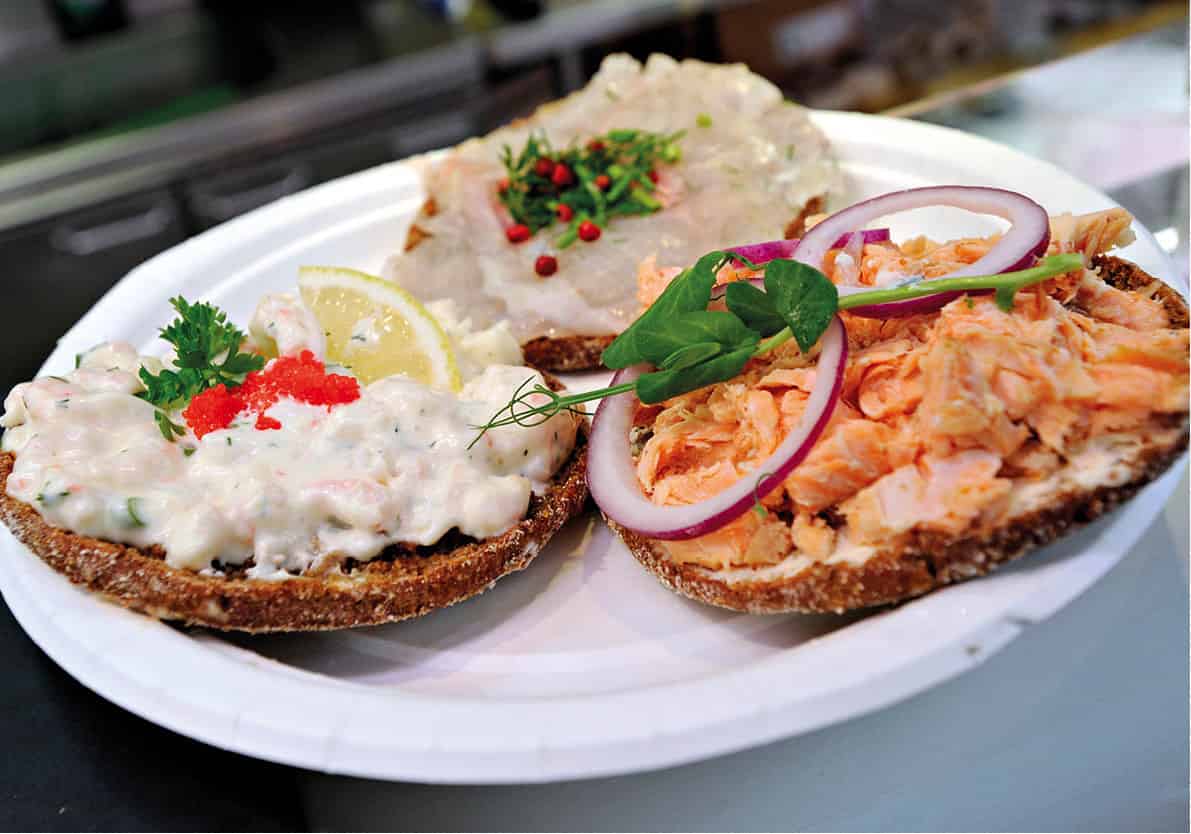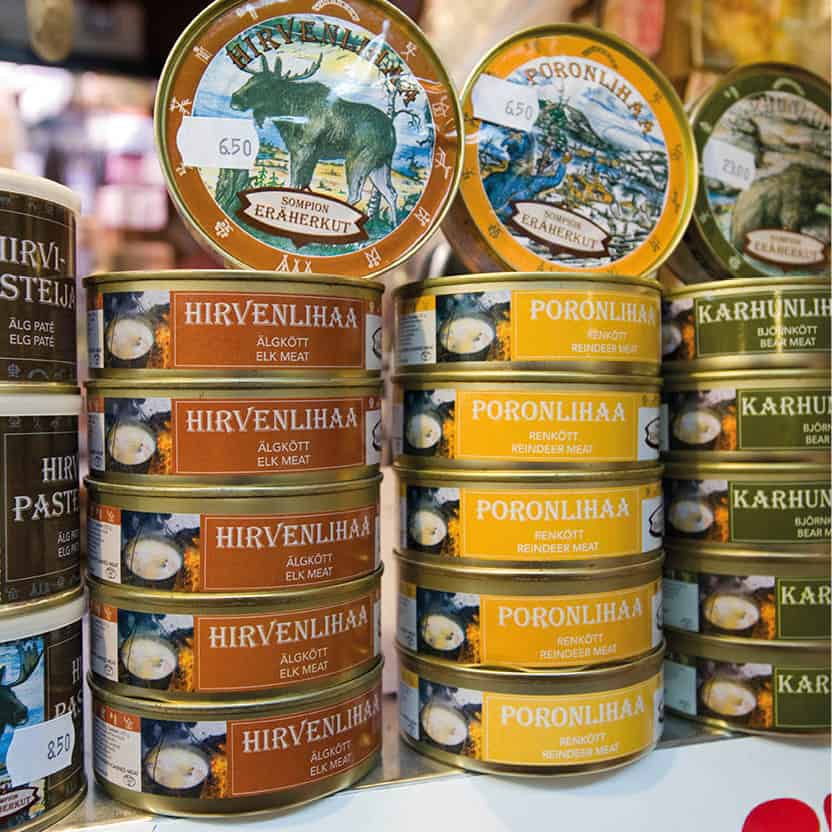Food History
Unlike other parts of Europe, Finland never had a strong bourgeoisie with the wealth and leisure to develop rich culinary traditions. The country’s food history is a tale of austerity. Finland’s isolated rural economy and unforgiving climate, with short summers and long winters, meant that harvested food had to last for six or more months. Finns depended on dried, smoked and pickled meats and fish dishes that would keep for several seasons.
Luckily for visitors, the situation today is different. Modern menus have been heavily influenced by the New Nordic Kitchen movement, which arose in Denmark in 2004. The movement advocates using local, organic and sustainable products, and has seen the Nordic countries, including Finland, develop a fresh pride and enthusiasm for ingredients that are unique to the region. There is also a sense of playfulness, as old-style “grandmother’s” recipes are revisited and revitalised to suit modern tastes.
Finland was fought over for centuries by its Swedish and Russian neighbours, and both countries have had a heavy influence on its cuisine. Stroganoff, hotpots, squidgy black bread, blinis, sauerkraut and pasties such as the rice-stuffed karjalanpiirakat hail from Russia; while meatball dishes, hard cheeses, and a startling selection of pickled herring are some of Sweden’s gifts. The Swedish smörgåsbord has also found its way to Finland, where it is known as seisova pöytä. A few Helsinki restaurants also have Sámi-influenced menus, showcasing Arctic specialities such as reindeer and bear.

Outdoor cafés are popular in summer
Gregory Wrona/Apa Publications
Where to eat
Helsinki has a wide selection of eating places, ranging from four Michelin-starred restaurants (Ask at Vironkatu 8; Chef & Sommelier at Huvilakatu 28; Demo at Uudenmaankatu 9–11; Olo at Pohjoisesplanadi 5) to streetside kiosks selling grilled food. Most of the city’s restaurants produce food to a high standard, and have menus that change with the seasons: look for crayfish in July, chanterelles in August, Baltic herring in September, and goose, moose and reindeer in the autumn hunting season. There are also an increasing number of restaurants serving cuisine from other cultures, with classy Japanese, Chinese, Lebanese, Indian and Latin American options available.
As in other Nordic countries, where long winter days make summer sunshine all the more precious, outdoor cafés and bars are popular in the warmer months. It’s a rare pleasure to sit on a green terrace, savouring a light lunch and watching the crowds pass by. Cafés are also the place to participate in a vital Finnish ritual, the consumption of coffee and pulla, sweet buns flavoured with cardamom.
Foodies should visit the city’s markets. In summer, stalls on the market squares overflow with seasonal fruit and veg. In winter time, head inside: the indoor market halls can provide you with fresh fish, meat and game, as well as delicatessen-style nibbles.
The Abattoir (Teurastamo), in the Sörnäinen district northeast of the centre, has become a foodie paradise with several restaurants, an ice-cream factory and a “flavour laboratory”, and events such as a monthly farmers’ market, a night market and the summertime “Street Food Thursday”.
Tastes from the Trees
Finland’s whispering forests have added extra flavour to the nation’s food. Edible substances have been found in all three of the country’s most common trees. Birch gives Xylitol, a sweetener very kind to teeth; spruce spring shoots are used to make sweet jam, a delicacy served with desserts; and pine is a good source of tar, extracted from the tree in traditional tar-burning pits. The light tar has a soothing aroma, and is used in Finnish sweets and ice cream. Pine is also raw material for the Finnish-invented Benecol, a margarine-style spread that has been found to have cholesterol-lowering qualities.

Fresh seafood toasts
VisitFinland
Finnish cuisine
Fish
Fish has always been important in the Finnish diet – unsurprising, considering the country’s myriad lakes and rivers and long, long coastline. Bream, burbot, perch and pike are traditional species, and salmon are omnipresent. What isn’t available locally can be readily imported from neighbouring countries such as Norway.
Smoked fish is a speciality, although it may also be grilled, glow-fired, steamed, or basted in the oven.
Salmon soup (lohikeitto) is another subtle delicacy: only a pinch of salt is added to the liquid, but the main taste comes from the fish. Each way of cooking salmon in Finland gives a distinctive experience, but graavi lohi (raw salmon marinated for a day in salt and herbs) is delicious. Graavi is the Finnish version of sushi – but instead of rice and seaweed, it is served with small potatoes and dill.
While Finnish salmon should not be missed, don’t forget to try siika as well. This white fish has a more subtle taste, and is also best in the graavi variety, with potatoes and dill. Tiny vendace (muikku), sometimes served with garlic and cream, are an ever-popular Finnish snack: this unpretentious little fish has more taste than all tropical varieties combined. Lamprey, a strange, jawless fish found in the rivers of western Finland, is another fine experience of Finnish haute cuisine. It is nearly always charcoal-grilled and eaten whole.
Meat and game
Much of Finland’s tasty elk meat disappears into private freezers during the hunting season, but semi-domesticated reindeer is more common. The Lapland speciality is poronkäristys (reindeer casserole), served with mashed potatoes and cranberry (lingonberry). The best part of reindeer is fillet steak, but a real delicacy is smoked reindeer heart, with a cedar aroma and a subtle taste. You can find this latter dish on the menu at Juuri (for more information, click here). The best restaurants in Finland also serve game birds in season (late summer/autumn), with wild duck being most common.
Sausage (makkara) is very popular in summer – best grilled with local mustard. It also appears in the traditional Finnish soul food dish pyttipannu, a hash of fried potato, sausage and onions, topped with fried eggs. Meatballs (lihapullat) are another sturdy staple deriving from Sweden.
Vegetables, fruit and grains
Rye bread (ruisleipä) is king in Finland, and served at every meal. It has an amazing ability to resist spoiling: in Finland’s agrarian past, farmhouses had an annual baking day, and the resulting rye bread was then eaten over the course of the year. Common forms include leavened crispbread (näkkileipä), dried into thin slices; and the stickier, harder jälkiuunileipä, delicious with cheese and cold milk.
Barley is a traditional staple, which some restaurants are reintroducing to replace rice and pasta (which are common in Finland too). Barley, oats, rye and rice are all used for porridges, typical breakfast items in Finnish homes.
Potatoes are available all year round, but their most delicious incarnation is as the tiny, nutty new potatoes that come into season in July.
Root vegetables and brassicas traditionally kept Finns going through the winter. Swede, turnip and cabbage are seldom considered “gourmet food”, but some restaurants such as Restaurant Aino (for more information, click here) make a virtue of them in dishes such as beef and barley-filled cabbage rolls (kaalikääryleet), served with mashed potatoes and lingonberry jam.
One special element in Finnish cuisine is the abundance of wild berries, fungi and herbs, gathered from the forests. Blueberries and sweet, wild strawberries are readily available in July, the native sour cranberries (lingonberries) by September. Out of 2,000 varieties of Finnish fungi, around 500 are edible – many varieties turn up in restaurants and on market stalls in August and September.
Vegetarians
Even as recently as 10 years ago, vegetarians were met with bafflement. Today there are several restaurants in the city that serve only vegetarian, vegan and gluten-free fare. Most other Helsinki restaurants have at least one vegetarian option on the menu.
Sweet treats
Berries are often used to create juicy desserts, such as blueberry pie, tart-tasting lingonberry pie, strawberry cake and the delightfully named lakkakakku (cloudberry cake).
Stodgier fare includes doughnuts and cinnamon buns, usually eaten with morning coffee. For a love-it-or-hate-it snack, look out for salt liquorice in supermarkets.

Tinned reindeer meat
Gregory Wrona/Apa Publications
Speciality food
Finland is a large country, and all kinds of regional delicacies have evolved over the years. Many make their way to Helsinki: look out for Tampere’s mustamakkara (“black sausage”), which contains spices, barley and blood in real gut; delicious Karelian pasties, filled with buttery rice; the strange, “squeaky” cheese leipäjuusto, from the northwest coast, often eaten with yellow cloudberries; and bear meat and reindeer stew (poronkäristys) from Lapland.
Christmas food in Finland is very traditional, and still very much loved, in spite of being rather simple by today’s standards. Little has changed on the festive menu over the past century: ham, salmon, casseroles and dried codfish always feature, and there are plenty of desserts, including ginger biscuits and the popular star-shaped plum tart, joulutorttu. At Easter, Finns consume mämmi (a malt-based pudding) and drink sima (mead), while tippaleipä pastries are the May Day speciality. Festival times apart, Finnish food varies both seasonally and geographically, making it an endless source of fascination and providing pleasant surprises for visitors to the country.
Meal times
Meal times are early compared to some European cities – usually 6.30am–10am for breakfast, 11am–1pm for lunch and 6.30–9pm for dinner. Inexpensive lunches (lounas) can be had at cafés (kahvilat). Note that restaurants may close on Sunday and/or Monday, and many shut completely for the month of July.
Coffee lovers
Soldiers building the Suomenlinna Fortress were the first to bring coffee to the country. Today, Finns are the world’s biggest coffee drinkers, consuming a staggering 12kg (26 lbs 6 oz) per person per year!

Coffee is big business in Finland
Visit Helsinki
What to drink
Medium-strength beer is available at most cafés, and a full range of beverages is sold at fully licensed restaurants and bars. Restaurants serve beer from 9am and other alcoholic drinks from 11am, but stop serving them half an hour before they close. The basic measures are 4cl (1.3fl oz) for spirits, 8cl (2.7fl oz) for fortified wines and 12cl (4fl oz) for table wines; beer is served either in 0.33-litre (0.7 pint) bottles or in 0.4-litre (0.8 pint) glasses. Not all restaurants are licensed, so check before you go. The minimum legal age for drinking alcohol in restaurants is 18.
Beer is ubiquitous, and one of the “big five” is most usually served: Koff, Lapin Kulta, Karhu, Karjala or Olvi (this last is in fact the only major brewery still Finnish-owned). Most beer is usually 4.5 or 5.2 percent, stronger brews can reach 7 percent.
Wine, relatively expensive, is often drunk with meals, and you will find both local and imported vintages on offer. There are now around 40 wineries in Finland. Strawberries, blackcurrants and redcurrants, among others, are used to produce a distinctive red wine – not exactly Burgundy, but it is a well-balanced berry drink with 12 percent strength.
Vodka is particularly popular in Finland and Finlandia is the country’s best-selling brand, distilled with crystal-clear water that has been naturally filtered through deep moraine ridges. Berries grow everywhere and the Finns use them to make liqueurs, such as Lapponia Lakka, which is made from cloudberries.
The sale of alcohol is strictly controlled in Finland; strong beer (over 4.7 percent), spirits and wine can be bought only from Alko (the state alcohol monopoly); Stockmann’s department store in Helsinki has an Alko unit on the ground floor. Medium- and lower-alcohol beer can be bought in supermarkets.